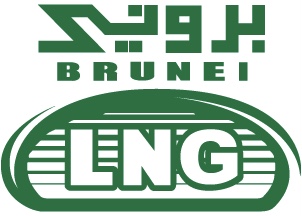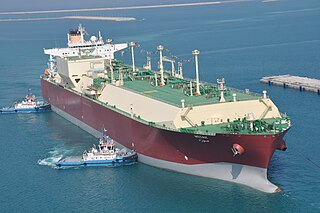
A cargo ship or freighter is a merchant ship that carries cargo, goods, and materials from one port to another. Thousands of cargo carriers ply the world's seas and oceans each year, handling the bulk of international trade. Cargo ships are usually specially designed for the task, often being equipped with cranes and other mechanisms to load and unload, and come in all sizes. Today, they are almost always built of welded steel, and with some exceptions generally have a life expectancy of 25 to 30 years before being scrapped.

Liquefied natural gas (LNG) is natural gas (predominantly methane, CH4, with some mixture of ethane, C2H6) that has been cooled down to liquid form for ease and safety of non-pressurized storage or transport. It takes up about 1/600th the volume of natural gas in the gaseous state at standard conditions for temperature and pressure.

A merchant ship, merchant vessel, trading vessel, or merchantman is a watercraft that transports cargo or carries passengers for hire. This is in contrast to pleasure craft, which are used for personal recreation, and naval ships, which are used for military purposes.

A floating production storage and offloading (FPSO) unit is a floating vessel used by the offshore oil and gas industry for the production and processing of hydrocarbons, and for the storage of oil. An FPSO vessel is designed to receive hydrocarbons produced by itself or from nearby platforms or subsea template, process them, and store oil until it can be offloaded onto a tanker or, less frequently, transported through a pipeline. FPSOs are preferred in frontier offshore regions as they are easy to install, and do not require a local pipeline infrastructure to export oil. FPSOs can be a conversion of an oil tanker or can be a vessel built specially for the application. A vessel used only to store oil is referred to as a floating storage and offloading (FSO) vessel.
QatarEnergy LNG, formerly Qatargas, is the world's largest liquefied natural gas (LNG) company. It produces and supplies the globe with 77 million metric tonnes of LNG annually from across its seven ventures—QatarEnergy LNG N(1), QatarEnergy LNG N(2), QatarEnergy LNG N(3), QatarEnergy LNG N(4), RL1, RL2 and RL3. It is headquartered in Doha, Qatar, and maintains its upstream assets in Ras Laffan, Qatar. Natural gas is supplied to the company's LNG trains from Qatar's North Field, by far the world's largest non-associated gas field. It reached a record LNG production of 77 million tonnes per year in December 2010. According to Brand Finance, QatarEnergy LNG is the world's fastest growing oil and gas brand in 2023. QatarGas is said to be used through gas diplomacy as leverage by Qatar on the EU and India to advance its interests and silence criticism of its human rights violations and corruption.
RasGas Company Limited was a liquefied natural gas (LNG) producing company in Qatar. It was the second-biggest LNG producer in Qatar after QatarEnergy LNG. RasGas operated seven LNG trains located in Ras Laffan Industrial City. It was merged with Qatargas on 1 January 2018.

An LNG carrier is a tank ship designed for transporting liquefied natural gas (LNG).

The Brunei LNG (BLNG) is the LNG plant in Lumut, Brunei. It is the largest oil and gas producer in the country. Moreover as of 2006, Brunei has been the 4th largest oil producer in Southeast Asia and the 9th largest LNG producer in the world.
Q-Flex is a type of ship, specifically a membrane type liquefied natural gas carrier.
Golar Spirit is a floating storage and regasification unit (FSRU). It is the world's first FSRU converted from a liquefied natural gas (LNG) carrier.

South Hook LNG terminal is an LNG regasification terminal near Milford Haven and is the largest LNG terminal in Europe. Together with the smaller Dragon LNG terminal nearby, it can handle up to 25% of the UK's gas requirement. The first tanker docked on 20 March 2009.
A double acting ship is a type of icebreaking ship designed to travel forwards in open water and thin ice, but turn around and proceed astern (backwards) in heavy ice conditions. In this way, the ship can operate independently in severe ice conditions without icebreaker assistance but retain better open water performance than traditional icebreaking vessels.

Qatar Gas Transport Company Limited, commonly known as Nakilat is a Qatari shipping and maritime company. Its LNG shipping fleet is one of the largest in the world, comprising 74 vessels. The company also jointly owns one Floating Storage Regasification Unit (FSRU) and 4 very large LPG carriers (VLGCs). Through its in-house ship management, Nakilat manages and operates the four very large LPG carriers and 14 LNG carriers.

A liquefied natural gas terminal is a facility for managing the import and/or export of liquefied natural gas (LNG). It comprises equipment for loading and unloading of LNG cargo to/from ocean-going tankers, for transfer across the site, liquefaction, re-gasification, processing, storage, pumping, compression, and metering of LNG. LNG as a liquid is the most efficient way to transport natural gas over long distances, usually by sea.

Klaipėda LNG terminal is an liquefied natural gas import terminal in the port of Klaipėda, Lithuania. It cost US$128 million to construct. The developer and owner of the project is KN Energies.

A marine LNG engine is a dual fuel engine that uses natural gas and bunker fuel to convert chemical energy in to mechanical energy. Due to natural gas' cleaner burning properties, the use of natural gas in merchant ship propulsion plants is becoming an option for companies in order to comply with IMO and MARPOL environmental regulations. The natural gas is stored in liquid state (LNG) and the boil-off gas is routed to and burned in dual fuel engines. Shipping companies have been cautious when choosing a propulsion system for their fleets. The steam turbine system has been the main choice as the prime mover on LNG carriers over the last several decades. The decades-old system on steam propelled LNG carriers uses BOG. LNG carriers are heavily insulated to keep the LNG at around -160 °C – to keep it liquefied. Despite insulation, the LNG containment area is penetrated by heat which allows for naturally generated boil-off gas (BOG).

Mozah is a Q-Max LNG carrier operated by Qatargas II. The vessel was built in 2008 by Samsung Heavy Industries and is tied with her sister ships for the largest LNG carrier in the world. The vessel is part of a contract for 14 same-size ships with maximum particulars to berth at Ras Laffan terminal in Qatar.

Costa Azul LNG is a sea port and natural gas processing center, located 15 miles north of Ensenada, Baja California, Mexico. Opened in 2008, the terminal can process up to one billion cubic feet of natural gas per day. This is the first liquefied natural gas (LNG) terminal on the North America west coast. LNG carrier ships capable of holding up to 220,000m3 of LNG can dock in the deep water port off the coast to unload LNG. The natural gas from the terminal is used to produce electricity and is fed by pipe lines to factories. The longest pipeline runs north, to the United States. Sempra Energy is a partner in the port with PEMEX. The LNG ship Al Safliya was the first ship to port and unload at Costa Azul. The Al Safliya is a 210,000 cubic meter LNG ship, its LNG was from Qatar. The other Mexican LNG Terminal in the Pacific Ocean is at Manzanillo, Colima, the Manzanillo LNG Terminal.

The Jacques Saadé class is a group of nine container ships each with a capacity of 23,000 TEUs built by the China State Shipbuilding Corporation (CSSC) for French shipping company CMA CGM. Construction on the first two began in July 2018 in Shanghai by Jiangnan Shipyard and Hudong-Zhonghua Shipbuilding. The first ship was launched in September 2019. The first ship was delivered on 22 September 2020. The first two ships were originally expected to be delivered in 2019, but they have been delivered in September and October 2020 after a delay of at least 10 months by China State Shipbuilding Corporation (CSSC).
















